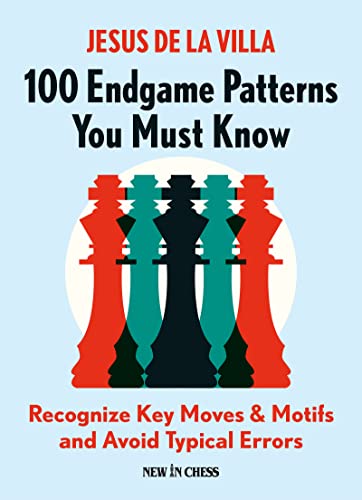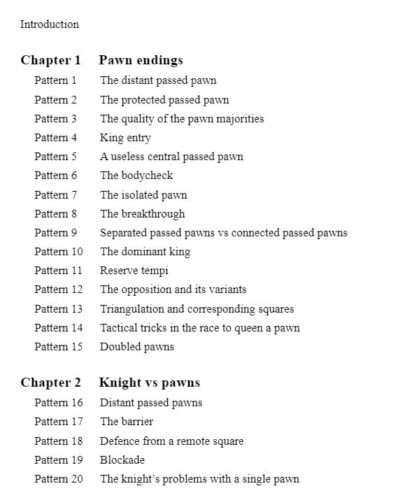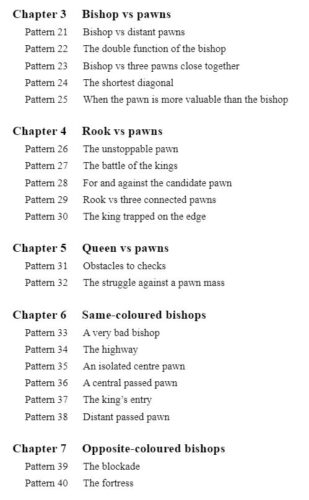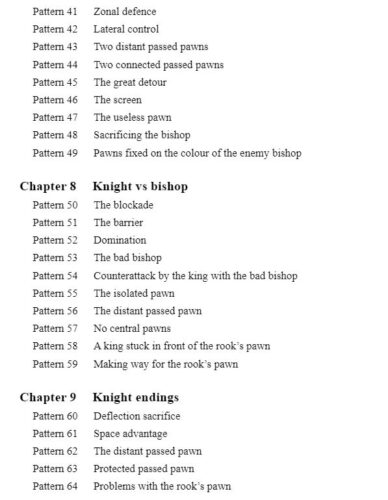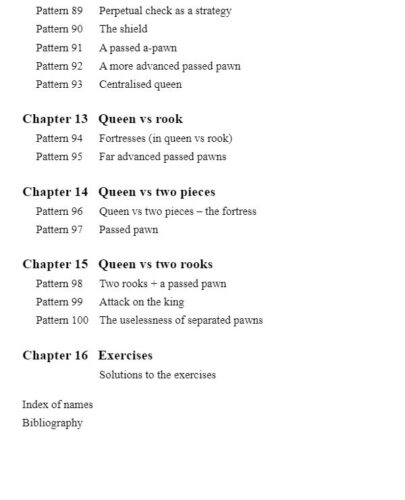Disclaimer 1: The following article contains several affiliate links to Amazon.com, meaning that if you go to Amazon and buy the recommended product (or some other product in an allotted period of time), the author of these lines will get a commission % from the purchase
Disclaimer 2: The following article is an excerpt from my article titled Best Chess Books 2022 in which I reviewed 20 chess books
Jesus De La Villa: 100 Endgame Patterns You Must Know
What is the book about?
After the big success of his first book titled 100 Endgames You Must Know, 1 the Spanish Grandmaster and coach Jesus de La Villa made a grand return in 2022 with another book on the topic of endgame, titled 100 Endgame Patterns You Must Know. 2
As the title suggests, the focus of the book is endgame patterns. Over the course of 16 chapters, the reader gets acquainted with some of the most important patterns/principles of endgame play, such as blockade, triangulation, distant passed pawns, reserve tempi, lateral defense, zonal defense, barrier, bad bishops, bad knights and many others. The division of the chapters is done on the basis of the piece composition – every chapter is devoted to a different composition (e.g. Rook endings or Knight vs Bishop) and then a set of patterns relevant to that exact piece composition is studied.
100 Endgame Patterns was envisioned as a follow-up/complementary book to 100 Endgames. While the latter primarily focuses on the most important theoretical positions, the 100 Endgame Patterns has a significantly more practical flavor.
The idea is that the two books in combination will provide the reader with a complete toolkit required to play the final phase of the game more successfully.
Why do I love this book?
Even though I am not the biggest fan of the modern tendency to oversimplify and „dumb down“ everything possible in every possible field of human endeavor, I do feel chess endgames are one of the areas where the simplification – especially for educational purposes – is very much necessary. Even though I definitely see the value in books such as The Dvoretsky Manual, I do feel the majority of the chess audience requires something a bit more comprehensible – especially at the beginning of the journey in the magical world of the endgames.
I am, therefore, a big fan of the concept introduced by a book such as 100 Endgames You Must Know. As a matter of fact, back in the day when I first read it, I felt the number of „essential“ positions could have been reduced even further, as I found the majority of these presented in the book mostly irrelevant for the practical play. 3
Thus, when 100 Endgame Patterns You Must Know, I immediately got myself a copy 4 and in 2022, I read it with great joy and interest.
First and foremost – I really liked the way this book was structured and organized. I think dividing the patterns on the basis of the piece composition is very clever and clear from a pedagogical standpoint. It is not a coincidence that another great endgame book I often recommend to people – Understanding Chess Endgames by GM John Nunn – adopts a very similar approach. 5
Second of all, I really liked the selection of examples presented in the book. I felt the choice was much more relevant and useful compared to the 100 Endgames. The majority of examples I have also seen for the very first time. 6 They were also quite varying in difficulty – some of them were very obvious for a player of my level, but some of them I found very challenging and insightful. I felt this variety provides a lot of value to players of different playing levels 7

Last but not least, I really like the way this book was edited and typeset. The abundance of diagrams makes it possible to read even without the board – especially since the majority of the examples/patterns are relatively short. This is usually the case with the majority of New In Chess Books 8, although there are some notable exceptions 9
It is true that some of the explanations could be more „verbose“ and thorough and that certain examples feature long variations proving the evaluation of the initial position in the Aagard/Dvoretsky style:

but these instances are few and far between and don’t spoil the general impression of the book.
As for the level – I do think that the book has a lot to offer to players in the range of, say, 1500(1700?)-2300 FIDE. I wouldn’t probably recommend it as your very first endgame book, 10, but I do think it is suitable to be the second or the third.
It is hard to say whether it is better or worse than, say, Understanding Chess Endgames, but I would definitely recommend it before 100 Endgames You Must Know or Shereshevsky’s Endgame Strategy. To say nothing about Dvoretsky’s Endgame Manual.
All in all, a very enjoyable, well-structured, and well-written book and a very welcome addition to the chess literature!
- Which is also available on Chessable
- Which is not available on Chessable…yet.
- And I think I am far from being the only one
- Ok, ok, convinced my girlfriend to get me one for last Christmas. HAPPY NOW?
- Although Nunn’s book is a bit less pattern-oriented than this one, which is the reason why I would probably prefer this one nowadays, given that the level of difficulty is approximately similar
- And they included quite a few recent games
- Although it doesn’t mean that the book is suitable for beginners, as will be elaborated quite soon.
- Especially those edited by the members of the Keetman family. Hi Sandra!
- Such as the book Sacrifice and Initiative, that will be reviewed later in this article.
- Let alone a chess book

